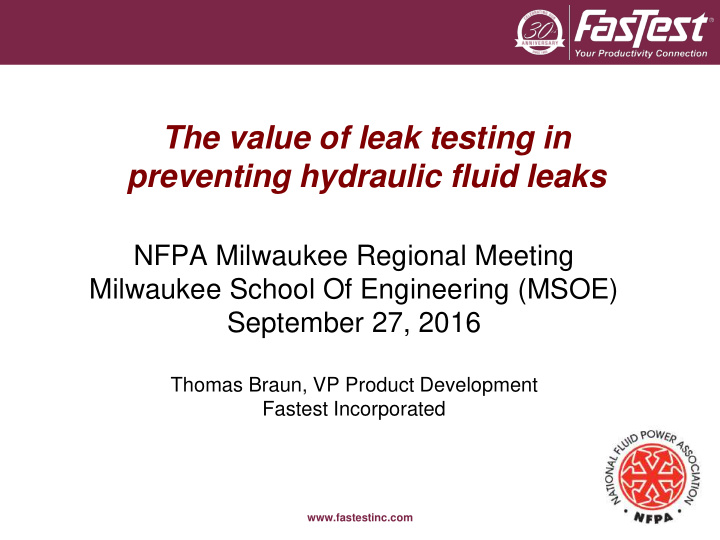



The value of leak testing in preventing hydraulic fluid leaks NFPA Milwaukee Regional Meeting Milwaukee School Of Engineering (MSOE) September 27, 2016 Thomas Braun, VP Product Development Fastest Incorporated www.fastestinc.com
2015 NFPA Technology Roadmap 6 broad areas of “challenge” • Increasing the energy efficiency of fluid power components and systems • Improving the reliability of fluid power components and systems • Reducing the size of fluid power components and systems while maintaining or increasing their power output ( higher working pressure ) • Building “smart” fluid power components and systems (i.e . ones that perform self ‐ diagnostics) • Reducing the environmental impact of fluid power components and systems (e.g., lowering noise, eliminating leaks) • Improving and applying the energy storage capabilities of fluid power components and systems www.fastestinc.com
It’s an Environmental Issue… • It is estimated that 700 million gallons (2.65 billion liters) of petroleum products enter the environment each year 1 • The hydraulic contribution is estimated to be 98 million gallons (370 million liters) 2 – This represents the amount of oil leaks from/out of hydraulic equipment each year! 1 National Oceanic & Atmospheric Association (NOAA) 2 Gates Corporation www.fastestinc.com
It’s an Economical Issue… • “Little Leaks” can easily cost <$2000/year/leak point 1 – Make-up oil • A 0.5cc/min leak = 263 liters/year @ $3/liter = $789 – Clean-up • $20/week for labor & consumables = $1000 – Disposal • @ $1/liter disposal cost x 263 liters = $263 – Contaminant ingression • Causes component damage ($) • Fluid degradation ($) • Downtime from reliability problems ($) – Safety “intangibles” 1 Brendan Casey: How little leaks keep hydraulic equipment users poor www.fastestinc.com
Unfortunately, it’s also a Performance Issue… • Internal system leaks also affect equipment performance – Slow operation = loss of efficiency – Increased hysteresis – Cylinder drift – Etc. • And they drive operators crazy!!! www.fastestinc.com
In short, “leak - free” is critical to trouble -free operation… and becoming more so all the time! • Fluid Power OEM’s are demanding more and more that new & remanufactured components be certified to meet leakage (internal & external) specifications • Suppliers are using post assembly leak testing to verify the performance of new or remanufactured components – These components include… www.fastestinc.com
NFPA Component Suppliers Require Leak Free! Hose Assy’s Fittings Cylinders NFPA Pumps & Valves Motors Manifolds www.fastestinc.com www.fastestinc.com
NFPA Equipment Customers do too! Agriculture: Tractors Windrowers Combines Construction: Marine: Excavators Ships Loaders Pleasure boats NFPA Skid steers Wave runners Dozers Cranes Industrial: Sweepers Automation www.fastestinc.com www.fastestinc.com
What are the common leak test methods? • Common methods – Water immersion – Bubble – Pressure decay – Helium leak – Etc. www.fastestinc.com
• Regardless of the leak test method used the objective is to perform the test in the shortest time possible with accurate results • Often times a Fitting is used to connect to a threaded port of a hydraulic/pneumatic component • Common interface’s include : – Threads (Female or male) • Taper (NPT & BSPT) • Straight – O-Ring Boss (ORB) – Fittings (JIC 37° Flare, ORFS, other compression) www.fastestinc.com
• A critical consideration is achieving a leak free seal to the component being tested. • Common practice today is to screw & torque a fitting or QD into the component port. This is inefficient (slow/time consuming) and can yield inconsistent results. In addition it can “damage” a new component (cylinder, pump, valve, etc.) just to test it! Screw in fitting for test www.fastestinc.com
• Top-Tip: Use a proper Quick Test Connector! – A tool designed for the job, i.e. repetitive, quick, leak free and non-damaging connections www.fastestinc.com
• Top-Tip: Use a proper Quick Test Connector! – A tool designed for the job, i.e. repetitive, quick, leak free and non-damaging connections www.fastestinc.com
• Top-Tip: Use a proper Quick Test Connector! – A tool designed for the job, i.e. repetitive, quick, leak free and non-damaging connections www.fastestinc.com
Quick Test Connectors… Fast - Reliable - Safer • Benefits • Feature – Saves time/pays for itself – Quick connect design quickly – Test does not harm – Damage-free connect component being tested – Pressure assisted – The higher the pressure internal compensation the better it seals – Torque-free connect – Relieves fatigue & injury – Multiple configurations – Sizes & Styles for most threads, fittings & tubes – Local, fast supply & – Made in USA service, local distributors www.fastestinc.com
• In Summary – Leaks are leading cause of lost performance • They are associated with many obvious and hidden costs ($$$) – Leaks are environmentally harmful – OEM’s and End -Users are demanding leak-free components – Component testing is common and a growing trend for Tier 1 & 2 suppliers and with remanufacturers and servicers – A reliable connection during a leak test is critical – Common fittings are slow to install/remove for a test, can cause damage, can contaminate the system and require torqueing which can lead to worker fatigue & long term injury – Using proper Quick Test Connectors can save time, seal reliably, eliminate contamination, reduce fatigue, long term injuries and workman’s comp claims/insurance premiums! www.fastestinc.com
Th Thank ank you u for r your ur atte ttention! ntion! Ask us about… www.fastestinc.com
Recommend
More recommend